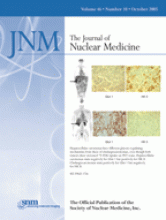Abstract
Radiolabeled somatostatin analogs have been shown to be important radiopharmaceuticals for tumor diagnosis and radionuclide therapy. The kidney has appeared to be the critical organ during radionuclide therapy because of peptide reabsorption and retention in the proximal tubules after glomerular filtration. The molecular mechanism of renal reabsorption of these analogs has not been clarified. A possible receptor candidate is megalin, a multiligand scavenger receptor in the renal proximal tubules. The objective of this study was to investigate the role of megalin in tubular reabsorption of radiolabeled somatostatin analogs by using kidney-specific megalin-deficient mice versus mice with normal renal megalin expression. [111In-Diethylenetriaminepentaacetic acid (DTPA)]octreotide was used as a practical model of peptide. Methods: Renal uptake of [111In-DTPA]octreotide was determined by animal SPECT scintigraphy at different time points after injection of the tracer and by measurement of radioactivity after isolation of the organs. Furthermore, ex vivo autoradiography of renal sections revealed the zonal distribution of radioactivity in the megalin-deficient and megalin-expressing kidneys. Results: SPECT scintigraphy of [111In-DTPA]octreotide at 3 and 24 h after injection clearly showed lower renal radioactivity in megalin-deficient kidneys than in megalin-expressing kidneys, both in male and in female mice, in accordance with counts obtained after isolation of the organ (70%–85% reduction of uptake in the megalin-deficient kidneys, P < 0.001). Renal uptake of [111In-DTPA]octreotide was significantly higher in female than in male kidneys (P < 0.001). Ex vivo autoradiograms clearly showed that renal radioactivity was not homogeneously distributed in the megalin-expressing kidneys but localized in the renal cortex. Quantification of the autoradiogram data confirmed the reduced radioactivity in the renal cortex of megalin-deficient kidneys. Conclusion: This study revealed the molecular mechanism of [111In-DTPA]octreotide uptake in renal proximal tubules involving the receptor megalin. Identification of megalin may be crucial for further research into strategies to reduce renal uptake.
Footnotes
Received Apr. 30, 2005; revision accepted Jun. 9, 2005.
For correspondence or reprints contact: Marion de Jong, PhD, Department of Nuclear Medicine, Erasmus MC Rotterdam, dr Molewaterplein 40, Rotterdam, 3015 gd, The Netherlands.
E-mail: m.hendriks-dejong{at}erasmusmc.nl







